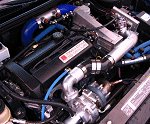

|
Street Class Unlimited Class
DOHC SOHC Ion Updated 1/05 For the most recent list of the fastest five cars click here. |
Tuning Your Turbo Saturnby: Qksl2MANAGEMENT BASICS GAY Firstly, having the ability to tune your car is the most important
aspect of tuning. The tools that will let you control timing, fuel,
and boost are the basis for a good tune. Management for turbo vehicles
tends to be complex, but you almost can't have too many aspects
of a setup's function to tune. Yes, some systems are "overly"
complex, but this extended tunability is likely a good thing. So
something that is "overly" complex is likely just a tuner's
lack of ability to tune. All engine management systems, from your
factory Saturn PCM to a full blown Tec III or FAST management system,
are just input/output devices. Considering a certain set of inputs,
they use pre-set calculations and algorithms to develop a certain
output. Simple Example: Given a Map Value of 200kpa, and an RPM
value of 4500, "x" amount of fuel required and "y"
amount of timing. Table modifiers are different input values that
the management system will take into consideration that alter the
outputs. For example, given an increase in air temperature of 10
degrees F, timing may be pulled ¼ of one degree and the VE
(or volumetric efficiency) table may be bumped up ½ a percent
across the board, which will add more fuel and compensate for the
extra heat and closer to pre-ignition conditions. The more raw table
modifiers the better, to the extent of the tuner's capabilities.
Some systems may allow you to pull timing or add fuel in relation
to knock. Some systems have user programmable air fuel ratio charts.
When the driver goes full throttle, the management will take note
of the difference between the desired or target air fuel ratio and
actual air fuel ratio. By datalogging the difference, the user can
then re-program the raw fuel curve to make the actual air fuel ratio
match the desired air fuel ratio. The factory computer has a certain
set of values that it defaults to I'm not going to go into the different tuning solutions available.
They vary greatly, most of which are untested, and our information
on these is changing every day. I don't want to put up information
that will be outdated shortly. So be that as it may, I'll give a
general overview to tuning your vehicle assuming that you have the
proper tools to do it. I cannot stress enough how important it is
to have a management system that you can tune thoroughly. While
simpler systems will work, it takes much more stress on the engine
to create the same power and usually compromises reliability or
drivability. Considering the amount of money most of us will easily
spend on a set of played out polished lip gunmetal wheels, a solid
engine management system IS NOT an "expensive" modification,
by any means! Period, no excuses! I only wish someone had told me
this when I PSYCHOLOGICAL TEWNING: First things first: get out of your head that your setup should
make this much power. Get out or your head that you should be able
to run this much timing. Or fuel, or boost. Get out of your head
that there is any baseline whatsoever from which to tune your car!
Is there a baseline that would likely be a good starting point?
Yes. But you have to literally convince yourself that there is not.
Get all the limits and parameters that you read about on some internet
board out of your PREPERATION TURDFirst thing to do when starting to tune a car is make sure it is mechanically sound. Spark plugs are probably the most critical thing to check on the initial setup of a turbo car. Check them often. When I first start a motor with a new setup, I check the plugs every time I turn the car off, or on. Yes, like every two or three minutes. Start it, monitor the gauges, listen to the motor, turn it off, check the plugs. Pull the dipstick, pay close attention to what the oil looks like; are there bubbles of air? What about any bits of condensation or water based liquid? Closer inspection will show you how much exhaust crud is getting past your rings. I'm not going to tell you how much there should be, or attempt to describe such variables. These are things that you will learn by experience, and by experience only. Sorry, no easy way out on that stuff. Change your oil often. Heard that before? Well, on this last setup, when starting the car for the first time with the stand alone, I changed the oil no less than 7 times in the first week. Why? I was running way rich, and running so rich causes the piston rings and cylinder walls to be washed with fuel. The fuel replaces the oil, and does not have any of the lubrication or cooling properties of oil. More turbo saturns blow due to weakened piston rings due to washed oil rings than anything else. Second reason? Throw a bunch of fuel in your oil, and have fun with your spun bearings! Compression. Check your compression. It doesn't have to be that high, it just has to be somewhat consistent. 140psi and above is ok. I've had 8.5:1 motor test anywhere between 135psi/cyl up to 190psi/cyl. It will vary, depending on the head gasket/valves/piston manufacturer. The head. Our lifters like to go bad, and most of the time we don't even know it. My guess is about half of us have stuck lifters. Pull the cams off, and take out your lifters. Do they squish? They should move. A lot of times they don't. There is no good way to see if they are getting too pumped up or bleeding down too much, but a set of lifters with minimal wear in the lifter bores and a "squishable" hydraulic center is important. Much of the intermittenthead clatter that sounds like a valve attempting to beat the sh1t out of itself is lifter noise. You can pretty clearly hear that it repeats itself at twice the speed of the crank. The Block: Please let your engine get up to temperature before you hammer on it. Forged engines take a few minutes of idling and a couple minutes of driving before things start to seal up. You can watch your vacuum get stronger as the rings start to seal up and everything expands to the correct tolerances. This is important to the life of the motor. For those of us exploring the upper limits of our motors' RPM capabilities, ditch your ARP main studs. Build your block with your mains align-bored by your machine shop, do not hot tank your block, and use a 2000 and newer lower girdle along with 2000+ main studbolts. When you do this conversion, there are small key screws that thread into the girdle itself to take up the room between the girdle and the stud. Make sure to use the factory pieces for this! When you go order your parts from the dealer, you'll see what I mean. Locktite the nuts that hold down the girdle, as well. Use clevite Tri-Metal bearings and plastigauge everything. One common fallacy is that low oil pressure is due to extra turbo
oil lines/oil cooler. As long as you fill your oil pan to compensate
for the extra volume needed for those parts, your oil pressure will
not be any lower. One common reason for low oil pressure among turbo
applications stems from a bad tune, and overly rich conditions.
This allows fuel into the oil, which thins it and ruins its ability
to be a barrier lubricant. It also dries out the cylinder walls
and allows you to wash out your rings.
Skip to page 3, 4 |
|




